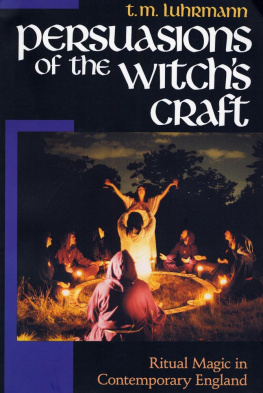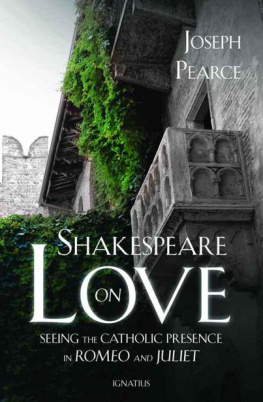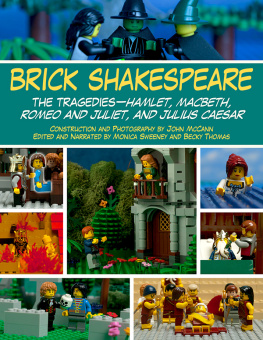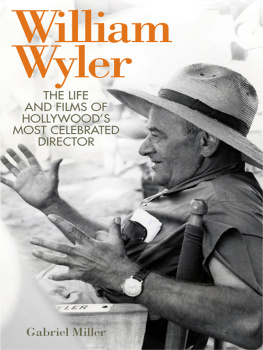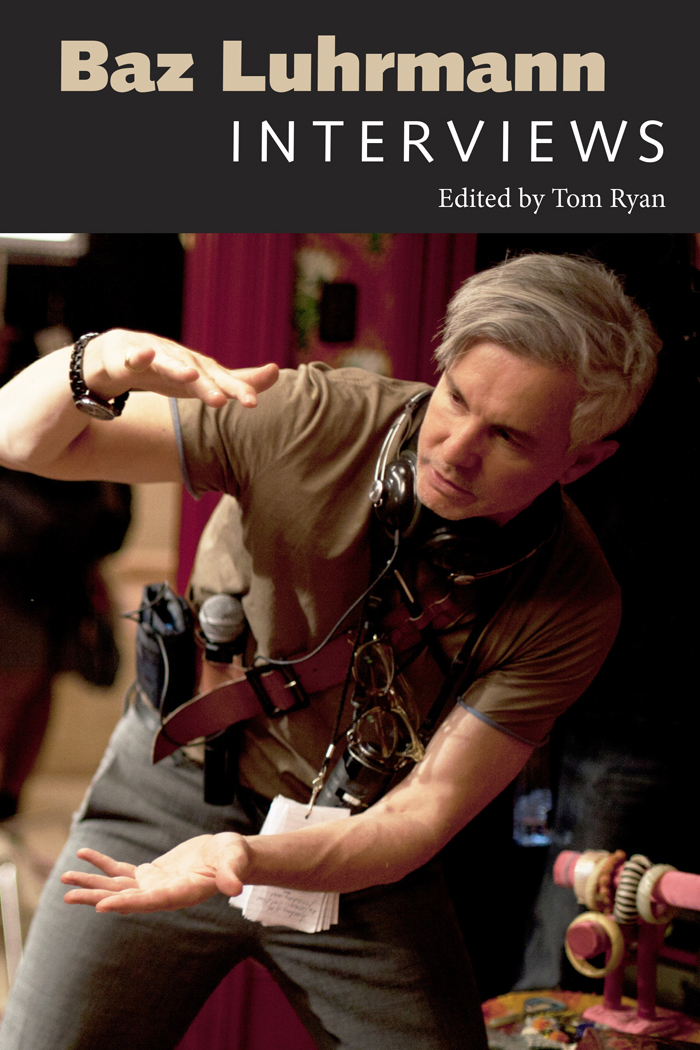Baz Luhrmann: Interviews
Conversations with Filmmakers Series
Gerald Peary, General Editor
Baz Luhrmann
INTERVIEWS
Edited by Tom Ryan
University Press of Mississippi / Jackson
www.upress.state.ms.us
The University Press of Mississippi is a member of the Association of American University Presses.
Copyright 2014 by University Press of Mississippi
All rights reserved
Manufactured in the United States of America
First printing 2014

Library of Congress Cataloging-in-Publication Data
Luhrmann, Baz.
Baz Luhrmann : interviews / edited by Tom Ryan.
pages cm. (Conversations with filmmakers series)
Includes bibliographical references and index.
Includes filmography.
ISBN 978-1-62846-149-7 (cloth : alk. paper) ISBN 978-1-62846-150-3 (ebook) 1. Luhrmann, BazInterviews. 2. Motion picture producers and directorsAustraliaInterviews. I. Ryan, Tom. II. Title.
PN1998.3.L839A3 2014
791.4309233092dc23 | 2014014369 |
British Library Cataloging-in-Publication Data available
Contents
Introduction
The magic of Baz is that hes one of those rare beings who can convince others the impossible can be possible. Craig Pearce
When youre the subject of something, you know, its very difficult. Im in the business of making stories about subjects, people. Im in the character analysis business. My own character has always been a bit elusive to me. Im also a storyteller... Ill tell you anything as long as it doesnt hurt someone else. Baz Luhrmann
Maybe Im sick of dancing somebody elses steps all of the time. Scott (Paul Mercurio) in Strictly Ballroom [1993]
Were gonna Baz the shit out of it. Sean (Patrick Brammall) in episode 4 of the Australian TV comedy series A Moody Christmas [2012], in reference to the creative approach he and his collaborators are planning to take to the production of a Nativity play.
Chronologically ordered, the interviews in this book trace the arc of Baz Luhrmanns career so far, taking us from the genesis of his 1993 film, Strictly Ballroom, based on the original thirty-minute theatrical production, through to the preparations for the 2014 stage version of Strictly Ballroom, which is in turn adapted from the film, and his plans for future projects. Along the way, the book also takes a sidelong glance at his eclectic output beyond his feature films, seeking insights there into both his work as a whole and his working methods.
The most obvious point to make about this portrait of an artist who loves to put on a show, preferably a musical, is that it has all the hallmarks of a star-is-born saga. The boy who ran away from home. The escape from the constraints of smalltown Australia to the excitements of the Big City. The search for a new direction: something full of color and style. His struggle to make a success of himself. The determination to do things his way and the refusal to bend to the dictates of others or back off in the face of public disapproval. The big hit that launched his career on a global scale. The discovery of a soul-mate. The international recognition that followed.
and by others too. He divides people, critics and audiences, but not those whove worked with him, the team hes built up around himself.
The antipathy of those who believe he hasnt earned the plaudits others have heaped upon him or the escalating budgets hes been able to extract from accommodating studios seems to have been fuelled by a resentment thats hard to explain. Perhaps its to do with the tall poppy syndrome, the desire to cut down to size people who are seen to have grown too big for their boots. Hes the small-town boy who now lists among his friends and acquaintances an abundance of Big Names from the arts and showbiz worlds, figures as disparate as Elton (John), Kenny (Branagh), Francis (Ford Coppola), and Kim (Kardashian). Who does he think he is?
Perhaps what is perceived as his constant self-promotion is responsible: heavily involved in the marketing of his films, he seems to embrace the attention of all strands of the media with the same intensity that they bring to him. Talk about a show off! Or perhaps the hostility is a consequence of his commitment to realms of the arts and entertainment worldsmusicals, opera, fashion, and musicthat are notoriously resistant to critical explication. Whatever the source, though, its frequently vicious.
In his review of The Great Gatsby, Peter Bradshaw of the Guardian wielded his wit like a weapon, describing Luhrmann as a man who cant see a nuance without calling security for it to be thrown off his set. He was similarly hostile to Australia.
For every excited celebration of Luhrmanns work, therell be a hostile denunciation. In an illuminating symposium published in 1998 by Cineaste magazinewhich includes contributions by Luhrmann, included in this volumeBritish director Oliver Parker, who brought Othello to the screen in 1995, describes Romeo + Juliet as passionate and poignant and hugely accessible. On the other hand, though, Franco Zeffirelli, who broke new ground with his own screen adaptation of Romeo and Juliet in 1968 (as well as making The Taming of the Shrew the previous year), was contemptuous of it. The Luhrmann film didnt update the play, he accuses. It just made a big joke of it. But apparently the pseudo-culture of young people today wouldnt have digested the play unless you dressed it up that way, with all those fun and games.
Marcia Langton, a descendant of the Yiman and Bidjara nations and professor of Australian Indigenous Studies at the University of Melbourne, enthusiastically sang the praises of Luhrmanns Australia, acclaiming it as a myth of national origin that is disturbing, thrilling, heartbreaking, hilarious, and touching.
The director is right when he observes, with a resigned shrug, My negatives arent just ordinary negatives. Theyre You Offend Me negatives. You have offended cinema. Its personal. Like all of us, he wants to be taken seriously. He knows his film history, draws upon it adventurously and would like those who disapprove of his endeavours to at least examine them seriously before passing judgement. Yet its rare to find any disapproving commentary about his work that goes far beyond the usual easy putdown-adjectives: flashy, indulgent, excessive, unsubtle, superficial, crass, and so on.
In the introduction to her book about him, Pam Cook perceptively touches on areas for further discussion. and, in the process, pointing to the modus operandi that has been in evidence throughout Luhrmanns career.
But his work generally remains an oeuvre calling out for in-depth analysis: both thematically and stylistically, theres an irresistible consistency to it. All of his films are about characters who come from different cultural backgrounds, are drawn together because of that, or despite it, and who either end up together or are driven apart by forces seemingly beyond their control. Scott and Fran in Strictly Ballroom. Romeo and Juliet. Christian and Satine in Moulin Rouge! Lady Sarah Ashley and the Drover With No Name in Australia. Gatsby and Daisy.
At the same time, the impulse to community and the need to belong drive them all, even as they struggle with the shackles of conformity that their circumstances impose on them. Luhrmanns films are preoccupied with how rigid attachments to class and cultural difference become causes of social breakdown, as destructive to the workings of a society as they are to the aspirations of its citizens. Given this, it would be seriously misguided to regard the very decorative trappings of Luhrmanns style and his films visual exuberance as ends rather than means.



